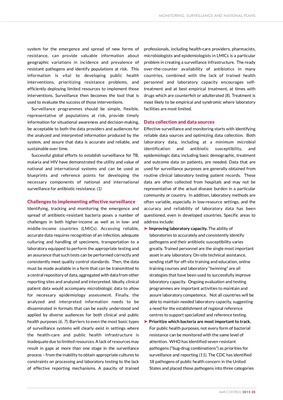
system for the emergence and spread of new forms of
resistance, can provide valuable information about
geographic variations in incidence and prevalence of
resistant pathogens and identify populations at risk. This
information is vital to developing public health
interventions, prioritizing resistance problems, and
efficiently deploying limited resources to implement those
interventions. Surveillance then becomes the tool that is
used to evaluate the success of those interventions.
Surveillance programmes should be simple, flexible,
representative of populations at risk, provide timely
information for situational awareness and decision-making,
be acceptable to both the data providers and audiences for
the analyzed and interpreted information produced by the
system, and assure that data is accurate and reliable, and
sustainable over time.
Successful global efforts to establish surveillance for TB,
malaria and HIV have demonstrated the utility and value of
national and international systems and can be used as
blueprints and reference points for developing the
necessary components of national and international
surveillance for antibiotic resistance. (1)
Challenges to implementing effective surveillance
Identifying, tracking and monitoring the emergence and
spread of antibiotic-resistant bacteria poses a number of
challenges in both higher-income as well as in low- and
middle-income countries (LMICs). Accessing reliable,
accurate data requires recognition of an infection, adequate
culturing and handling of specimens, transportation to a
laboratory equipped to perform the appropriate testing and
an assurance that such tests can be performed correctly and
consistently meet quality control standards. Then, the data
must be made available in a form that can be transmitted to
a central repository of data, aggregated with data from other
reporting sites and analyzed and interpreted. Ideally, clinical
patient data would accompany microbiologic data to allow
for necessary epidemiology assessment. Finally, the
analyzed and interpreted information needs to be
disseminated in formats that can be easily understood and
applied by diverse audiences for both clinical and public
health purposes (6, 7). Barriers to even the most basic types
of surveillance systems will clearly exist in settings where
the health-care and public health infrastructure is
inadequate due to limited resources. A lack of resources may
result in gaps at more than one stage in the surveillance
process - from the inability to obtain appropriate cultures to
constraints on processing and laboratory testing to the lack
of effective reporting mechanisms. A paucity of trained
professionals, including health-care providers, pharmacists,
microbiologists and epidemiologists in LMICs is a particular
problem in creating a surveillance infrastructure. The ready
over-the-counter availability of antibiotics in many
countries, combined with the lack of trained health
personnel and laboratory capacity encourages selftreatment
and at best empirical treatment, at times with
drugs which are counterfeit or adulterated (8). Treatment is
most likely to be empirical and syndromic where laboratory
facilities are most limited.
Data collection and data sources
Effective surveillance and monitoring starts with identifying
reliable data sources and optimizing data collection. Both
laboratory data, including at a minimum microbial
identification and antibiotic susceptibility, and
epidemiologic data, including basic demographic, treatment
and outcome data on patients, are needed. Data that are
used for surveillance purposes are generally obtained from
routine clinical laboratory testing patient records. These
data are often collected from hospitals and may not be
representative of the actual disease burden in a particular
community or country. In addition, laboratory methods are
often variable, especially in low-resource settings, and the
accuracy and reliability of laboratory data has been
questioned, even in developed countries. Specific areas to
address include:
‰ Improving laboratory capacity. The ability of
laboratories to accurately and consistently identify
pathogens and their antibiotic susceptibility varies
greatly. Trained personnel are the single most important
asset in any laboratory. On-site technical assistance,
sending staff for off-site training and education, online
training courses and laboratory "twinning" are all
strategies that have been used to successfully improve
laboratory capacity. Ongoing evaluation and testing
programmes are important activities to maintain and
assure laboratory competence. Not all countries will be
able to maintain needed laboratory capacity, suggesting
a need for the establishment of regional reference
centres to support specialized and reference testing.
‰ Prioritize which bacteria are most important to track.
For public health purposes, not every form of bacterial
resistance can be monitored with the same level of
attention. WHO has identified seven resistant
pathogens ("bug-drug combinations") as priorities for
surveillance and reporting (11). The CDC has identified
18 pathogens of public health concern in the United
States and placed those pathogens into three categories
MONITORING, SURVEILLANCE AND NATIONAL PLANS
AMR CONTROL 2015 35